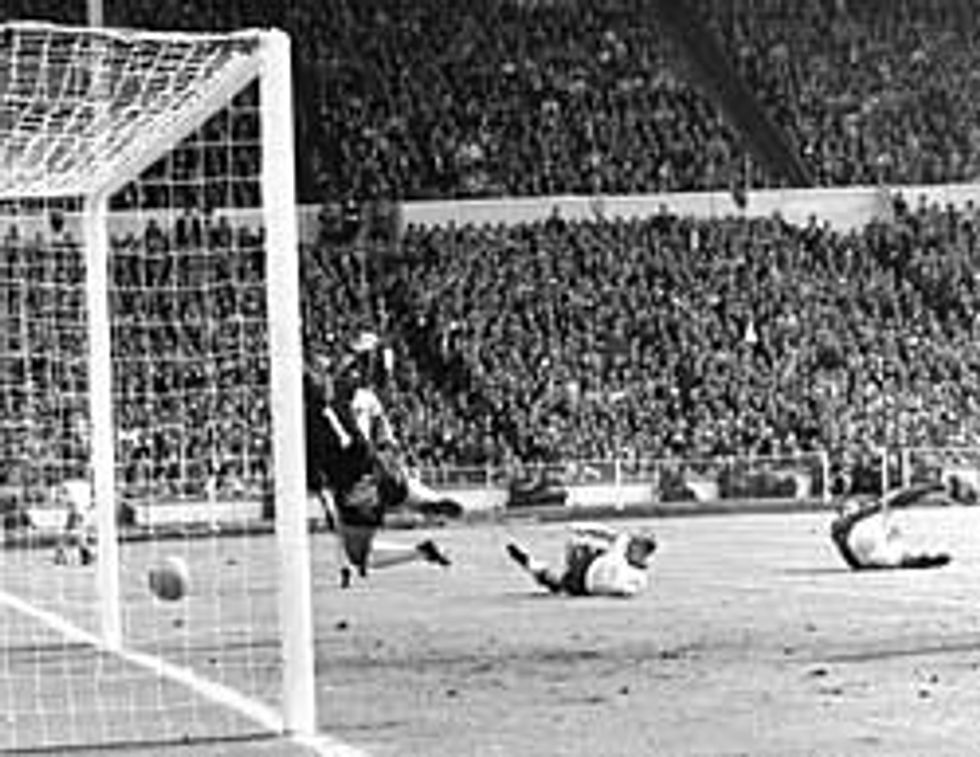Rene Dunkler and his colleagues at the Fraunhofer Institute for Integrated Circuits, in Erlangen, Germany, figured it was time to test their latest invention. So they got out of the lab and gathered at a soccer field nearby for some kicks. Their invention? It was in the center of the ball.
It is a coin-size radio transmitter that broadcasts a pulsed signal in the 2.4-gigahertz band to a dozen receivers mounted on floodlight masts and near the sidelines. The receivers relay the pulses to a central computer, which then calculates the ball's exact location.
Dunkler and the other researchers are now back in the lab, busily preparing to test the system in real matches at the FIFA U-17 World Championship--for players under the age of 17--next September in Peru.
Unlike other ball-tracking systems, which are based on video feeds, the Fraunhofer system works even when the ball seemingly disappears in a mass of footballers. By measuring the time it takes for each pulse to travel from the transmitter to the various receivers, it can pinpoint the ball's tridimensional coordinates through geometric calculations.
This technique is similar to the Global Positioning System, which relies on time delays of signals traveling from multiple satellites to a receiver. But the Fraunhofer system is accurate to within a centimeter or so, while a handheld GPS receiver can be off by several meters.
Cairos Technologies AG, in Ismaning, Germany, financed the project and will market the technology. The company partnered with the German sporting-goods giant Adidas-Salomon AG, in Herzogenaurach, which will make the special "bugged" balls.
The main goal, according to Cairos, is to help referees with tough calls, such as when a goalkeeper intercepts a ball on the fly after it has crossed the goal line. In such a case, the system would send a vibratory alert to a special wristwatch worn by the referee, signaling that the ball went over the goal.
Was it a goal?
A tracking system that alerts the referee if the ball crosses the goal line would have come in handy in the 1966 World Cup final, when a disputed goal helped England beat West Germany and win the title.
Another idea Fraunhofer and Cairos are studying involves embedding transmitters in the players' shin guards. Each transmitter would broadcast a signal with a unique identification code that would let the system track players individually.
With ball and players equipped with transmitters, soccer fans and team coaches would be able to know the speed of a shot or how close it passed by the goal, or determine which players ran the most during a game--or perhaps find the laziest.
Location systems like the one developed by Fraunhofer are finding their way into a number of applications beyond sports, because they work in closed spaces where GPS isn't always reliable.
"With GPS, the initial set of applications was quite narrow, but suddenly people came up with all sorts of different uses for it," says Andy Ward, chief technology officer at Ubisense Ltd., a company in Cambridge, England, that sells location systems for office automation and military training. "We think that with indoor [location technology], there is going to be a similar kind of move."
That means transmitters like those Adidas is putting into its balls may soon help track containers in warehouses, shopping carts in supermarkets, medical equipment in hospitals, and inmates in prisons. But first these transmitters have to get cheaper, costing tens of cents rather than tens of dollars, a challenge much like that faced by radio-frequency identification (RFID) tags.
In addition to cost, location systems for sports have their own unique technical challenges. For example, while a forklift may move about at 15 kilometers per hour, a soccer ball can move more than 10 times that fast. To track the ball, the Fraunhofer engineers linked the field's receivers with optical fibers and connected them to a Linux computer cluster that calculates the ball's position 2000 times every second.
Other problems involved transmission errors caused by humidity in the air, multiple reflections of the signals, and interference from cellphones. The engineers addressed these issues by placing fixed-reference transmitters on the field to help calibrate the receivers.
If the test in Peru goes well, will the system debut officially next year at the World Cup in Germany? Fraunhofer and Cairos say it's too early to know. But if it does, soccer fans may begin to scrutinize TV replays differently--by looking not at the ball but at the guy with the whistle. Is he checking his wristwatch?
